Sloviansk
Sloviansk (Ukrainian: Слов'я́нськ, romanized: Slov"jans'k[1] [slou̯ˈjɑnʲsʲk]; Russian: Славя́нск, romanized: Slavjansk[2] [slɐˈvʲansk]); prior to 1784 - Tor[3]) is a city of oblast significance in Donetsk Oblast, eastern part of Ukraine. It also serves as the administrative center of the Sloviansk Raion (district), though it does not belong to the raion. It was founded in 1676. The city was one of the focal points in the early stages of the 2014 pro-Russian conflict in Ukraine as it was the first city to be seized by Russia-backed military troops.[4][5] It was retaken by Ukrainian forces in July 2014. Population: 111,486 (2018 est.)[6].
Sloviansk Слов'янськ | |
|---|---|
 Former city bank building | |
 Flag 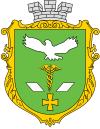 Coat of arms | |
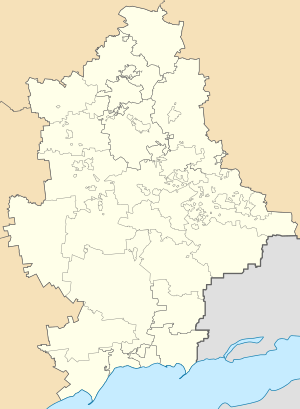 Sloviansk  Sloviansk | |
| Coordinates: 48°51′12″N 37°37′30″E | |
| Country | Ukraine |
| Oblast | Donetsk Oblast |
| Founded | 1645 |
| Area | |
| • Total | 58.9 km2 (22.7 sq mi) |
| Population (2013) | |
| • Total | 117,445 |
| Climate | Dfb |
| Website | http://www.slavrada.gov.ua/ |
History
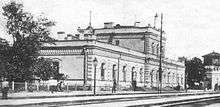
The history of Sloviansk dates back to the beginning of the 16th century when the first settlements formed by Ukrainian peasants appeared on its territory. Later on in 1645 was founded a border fortress against the Crimean attacks and slave raids on the southern suburbs of modern Ukraine and Russia.[7] In 1664 the first salt plant for the extraction of salt was built that caused the appearance of housing for workers.[8] In 1676, a fortress named Tor was built at the confluence of the Kazenyy Torets and Sukhyy Torets Rivers where they form the Torets River, a tributary of Donets River.[9] Shortly thereafter, the town of Tor grew up next to the fortress.[7]
As several salt lakes were located close by, the town became a producer of salt. During the sixteenth century, salt production was the principal local industry, but during the eighteenth century, it became unprofitable and ceased on December 21, 1782.
In 1784, the city was renamed Sloviansk, and it became a part of the Kharkov Governorate of the Russian Empire in 1797. A resort was established on the shores of Lake Ropne in 1832.
In April 1918 troops loyal to the Ukrainian People's Republic took control of Sloviansk.[10]
The city was occupied by the Germans on October 28, 1941. In December 1941, SS Einsatzkommando 4b executed more than a thousand Jews who lived in the city.[11] The Red Army temporarily expelled the Nazi occupiers on February 17, 1943. Germans retook it on 1 March 1943. Finally the Red Army retook it on 6 September 1943.
2014 clashes
On April 12, 2014, during the ongoing crisis following the 2014 Ukrainian revolution, masked men in army fatigues and bulletproof vests armed with Kalashnikov assault rifles captured the executive committee building, the police department, and SBU office in Sloviansk.[12] Ukrainian Interior Minister Arsen Avakov described the gunmen as "terrorists" and vowed to use the Ukrainian special forces to retake the building.[13][14]
On April 13, 2014, there were reports of fighting between the gunmen and Ukrainian troops, with casualties on both sides.[15][16] The BBC's David Stern described the pro-Russian forces as carrying Russian weapons and resembling the soldiers that took over Crimean installations at the start of the 2014 Crimean crisis.[15]
On May 29, 2014, a helicopter carrying fourteen army soldiers, including General Serhiy Kulchytskiy - the head of combat and special training for the country's National Guard, crashed after being shot down by militants near Sloviansk. Ukraine's outgoing President Olexander Turchynov described the downing as a "terrorist attack," and blamed pro-Russian militants.[17]
The city was held by Russia-backed separatists[18] until July 5, 2014; when pressed by the Ukrainian army they had to retreat from Sloviansk and pull back to Donetsk city.[19]
In 2015 a plaque to the memory of Volodymyr Rybak was placed in the town center.[20]
Demographics
According to the 2001 Ukrainian Census:[21]
| Ethnicity | ||
|---|---|---|
| Ukrainians | 104,423 | 73.1% |
| Russians | 33,649 | 23.6% |
| Turks | 829 | 0.6% |
| Belarusians | 766 | 0.5% |
| Armenians | 592 | 0.4% |
| Greeks | 320 | 0.2% |
| Roma people | 279 | 0.2% |
| Azerbaijanis | 208 | 0.1% |
Climate
The climate in Sloviansk is a mild to warm summer subtype (Köppen: Dfb) of the humid continental climate.
| Climate data for Sloviansk | |||||||||||||
|---|---|---|---|---|---|---|---|---|---|---|---|---|---|
| Month | Jan | Feb | Mar | Apr | May | Jun | Jul | Aug | Sep | Oct | Nov | Dec | Year |
| Daily mean °C (°F) | −5.9 (21.4) |
−5.4 (22.3) |
−0.2 (31.6) |
9.4 (48.9) |
16.2 (61.2) |
20.0 (68.0) |
21.7 (71.1) |
20.8 (69.4) |
15.5 (59.9) |
8.4 (47.1) |
1.8 (35.2) |
−2.5 (27.5) |
8.3 (46.9) |
| Average precipitation mm (inches) | 45 (1.8) |
34 (1.3) |
27 (1.1) |
39 (1.5) |
42 (1.7) |
57 (2.2) |
51 (2.0) |
40 (1.6) |
39 (1.5) |
30 (1.2) |
42 (1.7) |
44 (1.7) |
490 (19.3) |
| Source: Climate-Data.org[22] | |||||||||||||
Economy
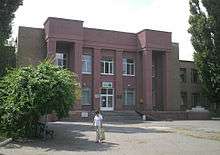
The principal industry of the city concerns machine building:
- The Slovvazhmash heavy-machinery production plant which produces chemical equipment for coke production and use for the businesses in Lipetsk, Kemerovo and Cherepovets. Companies in Mariupol, Kryvyi Rih, Donetsk, and Kamianske use their products.
- The Betonmash machine-building factory which produces concrete mixing plants, spare parts for mining equipment and metal works, parts for coke ovens. The factory provides foundry services for companies across Donetsk Oblast, Kharkiv Oblast, Dnipropetrovsk Oblast.
- The Sloviansk mechanical plant which employs approximately four hundred people. It produces chemical equipment for coke production as well as overhead cranes and other machinery.
- The Artem Armature-insulator factory.
- A factory producing high-voltage insulators for hydroelectric power stations and thermal power-stations.
Currently the city is an important health resort providing spa treatments and mud baths using mud from the bottom of salt lakes located nearby.
Transport
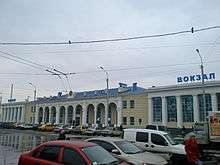
The city is a nexus of a number of railways and roads. There are three railway stations currently in use, one defunct. Three railway lines leave the city in directions of Lozova, Lyman and Kramatorsk. Ukrainian international highway ![]()
Religious organizations
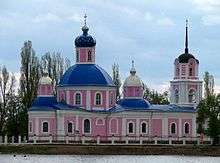
Christian churches:
- Cathedral of New Martyrs and Confessors of the Russian Orthodox Church
- Church of the Resurrection of Christ
- Church of the Andrew the Apostle
- Church of Oleksandr Nevskyi
- Church of Seraphim Sarovsky
- The "Kind New" Christian Center Church
- Church of Jesus Christ of the Protestant Church of Ukraine
Notable people
- Mykhaylo Sokolovsky, a Soviet footballer, record holder of the games played for Shakhtar Donetsk
See also
References
- "Slov"yans'k: Ukraine". Geographical Names. Retrieved 2014-04-15.
- "Slavyansk: Ukraine". Geographical Names. Retrieved 2014-04-15.
- "СЛОВ`ЯНСЬК , МІСТО ДОНЕЦЬКОЇ ОБЛ". resource.history.org.ua. Retrieved 2018-12-09.
- "'Casualties' in Ukraine gun battles". BBC News. 2014-04-13. Retrieved 2018-12-09.
- "WebCite query result". www.webcitation.org. Archived from the original on 2015-07-16. Retrieved 2018-12-09.
- "Чисельність наявного населення України (Actual population of Ukraine)" (PDF) (in Ukrainian). State Statistics Service of Ukraine. Retrieved 11 September 2018.
- "Города и области Украины. Справочник по Украине". Ukrainian.SU. Archived from the original on 2011-08-23. Retrieved 12 October 2010.
- "Славянск - город Тор, курорт и воин". sotok.net. Retrieved 2019-01-22.
- "Slov'yansk (Ukraine) - Encyclopædia Britannica". Britannica.com. Retrieved 2014-08-21.
- (in Ukrainian) 100 years ago Bakhmut and the rest of Donbass liberated, Ukrayinska Pravda (18 April 2018)
- http://yahadmap.org/#village/slovyansk-donetsk-ukraine.271
- Rachkevych, Mark (12 April 2014). "Armed pro-Russian extremists launch coordinated attacks in Donetsk Oblast, seize buildings and set up checkpoints". Kyiv Post.
- "Armed men seize police department in east Ukraine: minister". Reuters. 12 April 2014. Retrieved 2014-04-12.
- "Gunmen seize Ukraine police station in Sloviansk". BBC News. 12 April 2014. Retrieved 2014-04-12.
- "Ukraine crisis: Casualties in Sloviansk gun battles". BBC News. 13 April 2014.
- "Ukraine Army Launches 'Anti-Terror' Operation". Sky News via Yahoo! News. 13 April 2014.
- "General, 13 soldiers killed as militants down military helicopter". Russia Herald. Retrieved 29 May 2014.
- "Obama: Ukraine 'Vulnerable' To Russian 'Military Domination'". RadioFreeEurope/RadioLiberty. Retrieved 2019-01-22.
- "Ukraine President Poroshenko hails 'turning point'". BBC. Retrieved 6 July 2014.
- "Remembering Volodymyr Rybak: a year since the murder". EMPR: Russia - Ukraine war news, latest Ukraine updates. 2015-04-18. Retrieved 2020-04-18.
- Національний склад та рідна мова населення Донецької області [Ethnic and linguistic composition of Donetsk Oblast] (in Ukrainian). Archived from the original on 27 November 2012.
- "Climate: Sloviansk". Climate-Data.org. Retrieved 2 May 2014.
External links
| Wikimedia Commons has media related to Sloviansk. |
- (in Russian, Ukrainian, and English) Official website
- (in Russian) Unofficial website of Slavjansk Trolleybus system
- Marble sculpture of Nicolai Shmatko